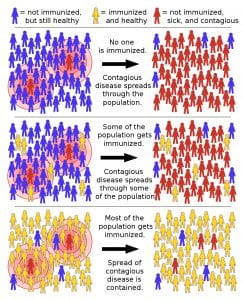Contact Networks, Herd Immunity, and Measles
This article is about the increase in measles among elementary schoolers in Connecticut due to more lenient vaccination regulations, i.e. religious exemptions to otherwise mandatory immunization. At such schools, vaccinated students now comprise less than 95% of all students— a value that the CDC (Centers for Disease Control and Prevention) has deemed necessary to maintain herd immunity.
Herd immunity is a term used to describe the protection from a disease that a community experiences when a high fraction of the community is immune. When no one in a community is vaccinated against a disease, a contagious disease will spread through the population; even when some members of a community are vaccinated, a contagious disease will still spread through some of the population and infect most. However, when many individuals in a community are vaccinated, the spread of a contagious disease is limited. Here is a diagram:
So, as you can see, whenever a high number of people are immunized (in this case, at least 95%) of a community is vaccinated, the population has achieved “herd immunity”, and the contagious disease cannot spread. The spread of a disease in a social network is a type of cascade in a network insofar as individuals with infected friends are much more likely to also become infected, and there exists a threshold of immunized people, below which a community becomes much more susceptible to infection. However, the spread of a disease in a social network works somewhat differently than the spread of a new technology in a community— individuals don’t get to choose whether or not to “adopt” a disease; the contraction of a disease is more random, and the transmission of a disease is reliant on a contact network whose structure models how a disease is spread. For example, since measles is airborne, the contact network includes a very high number of edges — anyone who breathed the same air would be connected by an edge: in other words, contact networks that have many edges indicate that a greater number of people are exposed to situations in which it is possible for them to become infected.
The expected number of individuals infected by previously infected individuals is known as the basic reproductive number of a disease, and this can be modeled by the equation R0= pk in which p is the probability that an uninfected individual becomes infected, and k is the number of individuals that an infected individual comes in contact with. When an individual is vaccinated, they cannot become infected. In effect, the vaccination of a high number of individuals in a community means that infected individuals run into fewer people susceptible to infection, and a disease’s reproductive number decreases. As the proportion of vaccinated members of a community increases, fewer and fewer people are susceptible to infection; eventually, herd immunity is achieved.
Achieving herd immunity within a community is important because it protects members who are susceptible to infection and cannot receive vaccination because of age, health conditions, and other factors such as allergies.

